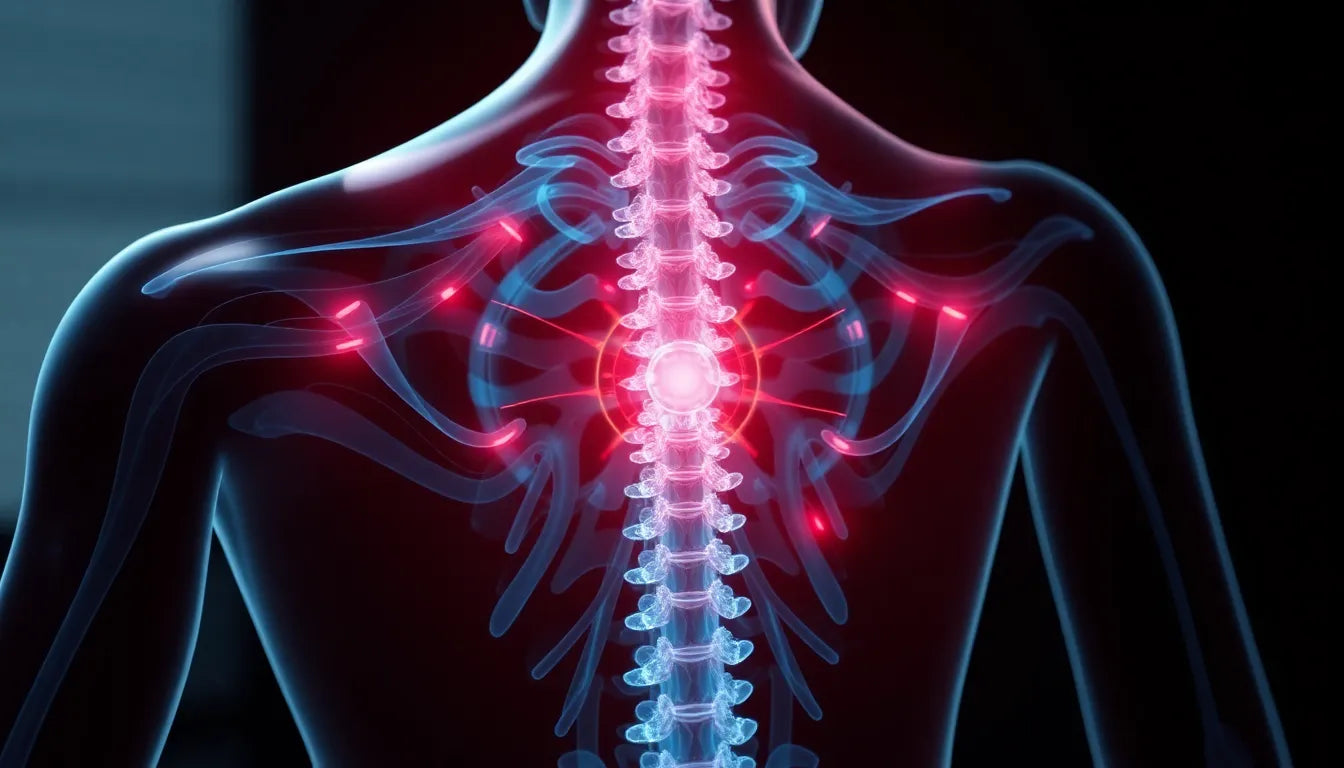Leg pain caused by a herniated disc is a common issue that affects many individuals, disrupting daily activities and diminishing quality of life. A herniated disc occurs when the soft inner gel of a spinal disc protrudes through its tougher outer layer, often leading to nerve impingement. This nerve compression can result in significant leg pain, as the nerves that run from the spine to the legs become irritated or inflamed. Understanding the connection between a herniated disc and leg pain is crucial for finding effective pain management strategies.
Understanding the impact of leg pain from a herniated disc
The prevalence of herniated discs and the associated leg pain is notably high, particularly among individuals aged 30 to 50. This condition can severely impact mobility, making everyday tasks challenging. The pain often radiates from the lower back down to the legs, a phenomenon known as sciatica, which can be debilitating. The constant discomfort not only affects physical capabilities but also has emotional and psychological repercussions, leading to frustration and decreased quality of life.
Addressing leg pain from a herniated disc is essential for restoring mobility and enhancing overall well-being. Effective pain management strategies are vital to prevent the condition from worsening and to maintain an active lifestyle. This blog post aims to explore various approaches to alleviate leg pain associated with a herniated disc, focusing on both conservative treatments and lifestyle adjustments.
The goal of pain relief strategies
Finding relief from leg pain due to a herniated disc involves a multi-faceted approach. The goal is to reduce pain, improve function, and prevent future episodes. By employing a combination of medical interventions, physical therapy, and home remedies, individuals can manage their symptoms and enhance their quality of life. This post will delve into these strategies, providing insights into how they can be effectively implemented to relieve leg pain.
Understanding the underlying causes and the impact of leg pain from a herniated disc is the first step in addressing the issue. With the right knowledge and strategies, individuals can take proactive measures to manage their condition and improve their daily lives. The following sections will provide detailed information on the mechanisms of pain, effective treatments, and when to seek medical attention, offering a comprehensive guide to managing leg pain from a herniated disc.
Mechanism of pain from herniated discs
Understanding the mechanism behind leg pain from a herniated disc is crucial for effective management. When a disc herniates, its inner gel-like substance pushes through the tougher outer layer, potentially compressing nearby spinal nerves. This compression triggers inflammation and irritation of the nerves, which can lead to radiating pain down the leg, commonly known as sciatica. The inflammation exacerbates the pain by adding pressure on the nerves, resulting in symptoms such as tingling, numbness, or weakness in the legs.
To visualize this process, imagine the spinal column as a stack of discs and bones, with nerves branching out to various parts of the body. A herniated disc disrupts this structure, pressing against the nerves that travel to the legs, causing the characteristic leg pain. This biological process highlights the importance of targeting both nerve compression and inflammation in treatment strategies.
Conservative treatments for leg pain relief
For many individuals, conservative, nonsurgical treatments can effectively manage leg pain from a herniated disc. One of the primary approaches is to balance rest and activity. Short periods of rest, typically between one to three days, can help reduce acute pain and inflammation. However, prolonged inactivity should be avoided as it may lead to muscle stiffness and prolong recovery time. Gradually resuming normal activities is essential to maintain muscle strength and promote healing.
Medications also play a crucial role in managing pain and inflammation. Nonsteroidal anti-inflammatory drugs (NSAIDs) such as ibuprofen or naproxen are commonly recommended to alleviate discomfort and reduce swelling around the affected nerves. These medications can be effective in providing short-term relief, but it's important to use them as directed by a healthcare provider to avoid potential side effects.
The role of physical therapy
Physical therapy is a cornerstone of conservative treatment for leg pain due to a herniated disc. A tailored physical therapy program can help strengthen the core and back muscles, improve flexibility, and facilitate recovery. Specific exercises, such as hamstring stretches and the McKenzie method, are designed to reduce pressure on the nerves and enhance spinal alignment. These exercises, performed under the guidance of a physical therapist, can significantly improve mobility and reduce pain.
In some cases, epidural steroid injections may be considered to provide short-term relief. These injections deliver anti-inflammatory medication directly to the area around the affected nerves, helping to reduce inflammation and alleviate pain. While they do not address the underlying cause of the herniation, they can be an effective component of a comprehensive pain management plan.
Home remedies and lifestyle adjustments
In addition to professional treatments, several home remedies and lifestyle adjustments can aid in relieving leg pain from a herniated disc. Heat and cold therapy are simple yet effective methods to manage symptoms. Applying heat can help relax tense muscles, while cold therapy can reduce inflammation and numb the pain. Alternating between these therapies can provide comprehensive relief.
Alternative therapies, such as the McKenzie method, specific sleep positions, massage, and hydrotherapy, offer additional avenues for symptom relief. These methods can help alleviate discomfort by promoting proper spinal alignment and reducing pressure on the affected nerves. Furthermore, topical pain relievers and transcutaneous electrical nerve stimulation (TENS) therapy can serve as adjunct treatments, providing localized pain relief and enhancing overall comfort.
By understanding the mechanism of pain and exploring a variety of conservative treatments, individuals can effectively manage leg pain from a herniated disc. The next section will discuss when to seek medical attention and provide a comprehensive conclusion on managing this condition.
When to seek medical attention for leg pain from a herniated disc
While many individuals find relief through conservative treatments and lifestyle adjustments, there are times when professional medical attention becomes necessary. Recognizing the signs that indicate a need for further evaluation is crucial. Persistent or worsening pain, despite following a comprehensive pain management plan, should prompt a consultation with a healthcare provider. Additionally, new symptoms such as numbness, weakness, or loss of bowel or bladder control require immediate medical attention as they may indicate nerve damage.
It is essential to consult a healthcare provider if conservative measures do not provide significant relief after several weeks. A medical professional can assess the situation, potentially recommending advanced diagnostic tests or alternative treatments to address the underlying issue effectively. Early intervention can prevent further complications and ensure a more favorable outcome.
Conclusion: A comprehensive approach to managing leg pain
Effectively managing leg pain from a herniated disc requires a comprehensive, individualized approach. By understanding the mechanisms of pain and exploring a variety of treatment options, individuals can find relief and improve their quality of life. From rest and medication to physical therapy and home remedies, each strategy plays a vital role in alleviating discomfort and promoting recovery.
It is crucial to remember that each person's experience with a herniated disc is unique, and what works for one individual may not be as effective for another. Therefore, consulting with a healthcare provider to develop a tailored plan is essential. By combining medical advice with lifestyle adjustments, individuals can take proactive steps towards managing their condition and enhancing their daily lives.
Visual aids and additional resources
To support the information provided in this blog post, consider utilizing visual aids such as diagrams or videos to demonstrate exercises and stretches. These resources can offer a clearer understanding of proper techniques and enhance the overall effectiveness of the treatment plan. Additionally, a table summarizing the pros and cons of different treatment options can serve as a quick reference guide for individuals seeking relief from leg pain caused by a herniated disc.
Frequently Asked Questions
What causes leg pain in herniated disc patients?
Leg pain is often caused by nerve impingement due to the herniated disc pressing on nearby nerves. This pressure leads to inflammation and irritation, resulting in pain that can radiate down the leg.
How long does it take to recover from leg pain caused by a herniated disc?
Recovery time varies depending on the severity of the herniation and the treatment approach. Many patients experience improvement with conservative treatments within a few weeks to months. However, it is important to follow a healthcare provider’s guidance for optimal recovery.
Are there specific exercises to avoid with a herniated disc?
Yes, it is advisable to avoid strenuous activities and exercises that put excessive strain on the back, such as heavy lifting or high-impact sports. Consulting a physical therapist can provide personalized advice on safe exercises to promote healing.
Can lifestyle changes help with leg pain from a herniated disc?
Yes, lifestyle adjustments such as maintaining a healthy weight, quitting smoking, and engaging in regular low-impact exercise can support recovery and reduce the risk of future episodes.
When should surgery be considered for a herniated disc?
Surgery is typically considered only when conservative treatments fail to provide relief, and symptoms persist or worsen, significantly impacting quality of life. A thorough evaluation by a healthcare provider can determine if surgical intervention is necessary.
Sources
- Mayo Clinic. (n.d.). "Herniated disk." Mayo Clinic.
- The Spine and Sports Center. (n.d.). "Herniated Disc Treatment." The Spine and Sports Center.
- Spine-Health. (n.d.). "Lumbar Herniated Disc Symptoms." Spine-Health.
- Cleveland Clinic. (n.d.). "Herniated Disc." Cleveland Clinic.
- OrthoInfo – AAOS. (n.d.). "Herniated Disk in the Lower Back." American Academy of Orthopaedic Surgeons.
- Penn Medicine. (n.d.). "Herniated Disc." Penn Medicine.
- Medical News Today. (2019). "Exercises and stretches for herniated disc pain relief." Medical News Today.



